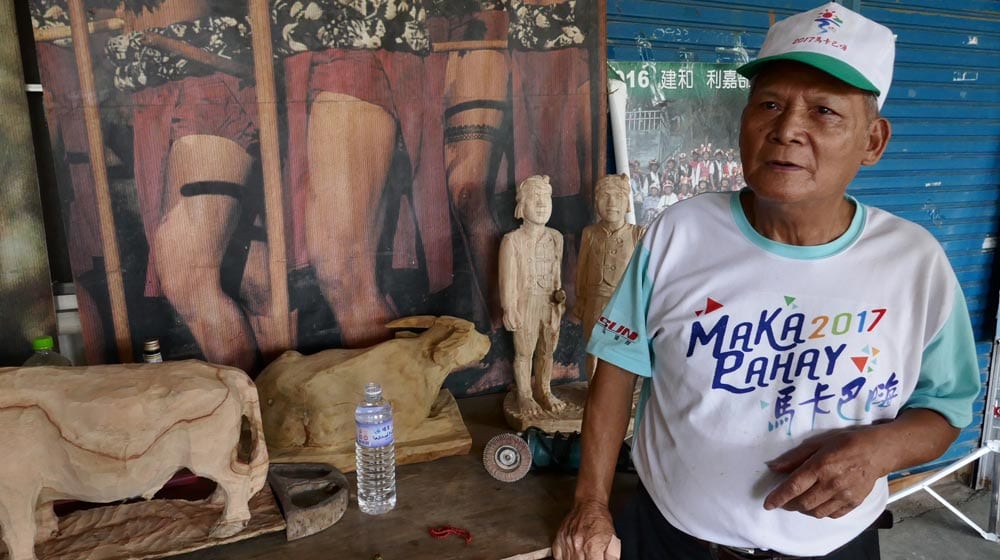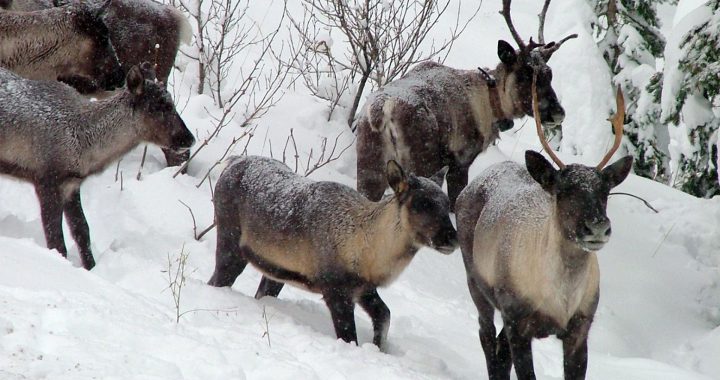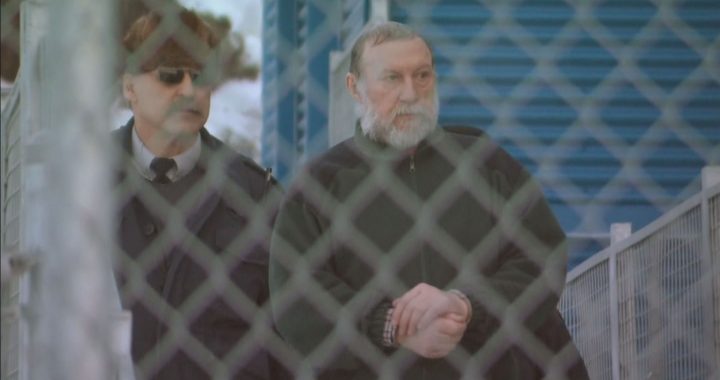
The national library in Taipei, Taiwan is bustling with a couple hundred academics, dignitaries, and politicians making their way to seats in the posh auditorium.
The occasion is the opening of the 2017 International Austronesian Conference, which brings together Indigenous movers and shakers from all over south-east Asia, New Zealand, and Australia.
Silence falls on the crowd when two dozen Bunun men and women walk on stage barefoot, garbed in traditional clothing.
Five men are carrying old rifles and woven bags which they lay on the floor.
The men crouch down in a semi-circle around the items with the women standing directly behind.
The silence is broken by an older man who lets out a melodic call that rises and falls, rises and falls.
There is the briefest of pauses before the rest of the Bunun men and women sing a swelling reply in a choir.
A beautiful harmony fills the auditorium.
The Bunun people gesturing towards the bags and rifles, their arms falling and rising in unison.
The song is calling animals to the guns of the men, it’s a ceremony that’s performed before a hunt.
There’s a sense of longing to the melody that borders on pleading, but it’s tinged with a hint of optimism too.
The audience, including Chen Chien-Jen the vice president of Taiwan, is captivated by the performance.
But intentional or not, there is an irony to one of Taiwan’s Indigenous tribes performing a hunting ceremony for members of the government.
“In the law, they say that Indigenous peoples are allowed to hunt only for ceremonies, only for certain occasions,” explains Tuhi Martukaw, 33, an Indigenous journalist and activist.
She is of the Piniyumayan people, who traditionally hunted in the mountains of the east coast.
Her people hold the belief that any bounty to come from the forest is a gift from their ancestors, and therefore has no business being regulated by the government.
Martukaw also says her community of Kasavakan isn’t the only one whose hunting traditions are not respected.
“In another community, before their annual festival, a very big ceremony, they applied for a hunting [permit], and the local government, they only permit them to hunt one deer, for a community for one thousand people,” Martukaw pauses to shake her head. “It’s insulting.”
Starting with the Dutch in the 17th century, the 16 recognized Indigenous groups of Taiwan have long faced an unceasing wave of colonialism. Ethnic Chinese, known as “Han”, flooded the island after the Dutch, but were forced to relinquish Taiwan to Japan in the late 19th century.
After World War II, the Chinese once again took control of the island that sits just 180 km west off China’s mainland.
Following a civil war in 1949, the Chinese communist party led by Mao Zedong exiled the ruling nationalist party from mainland China to Taiwan.
In just one year over two million Chinese inundated Taiwan, which to this day officially calls itself the Republic of China, although they are not recognized by the United Nations (UN).
Instead, the UN views Taiwan as part of the People’s Republic of China (P.R.C or mainland China).
Still, Taiwan is in many ways independent from the PRC, they have their own defacto government, currency, and laws.
Smaller than Nova Scotia, Taiwan is nonetheless brimming with 23 million inhabitants.
The cities here fit the Asian template with looming skyscrapers, markets washed in neon lighting, and traffic in a state of perpetual motion.
Much of the west coast is urbanized from the north to the south, but cross over the ring of mountains that divide the country to where they meet the Pacific coast and you’ll see why in the 16th-century Portuguese sailors named the island
“Formosa”.
It means “beautiful” and it still very much applies to the east coast where many of Taiwan’s 530,000 Indigenous people live.
* * *
Having spent part of his childhood in the U.S. and Europe, Asan Surot’s English skills have landed him a job as tour-guide in the community of Toruk.
Surot is Amis, which is Taiwan’s largest Indigenous tribe.
The Amis, as the 29-year-old Surot is proud to point out, are famous for their weaving and fishing skills.
In the 20th century, they also made a name for themselves as resistance fighters.
“After the harvest, you always had to give major cuts to the Japanese, so after a while of just being mistreated, they were fed up and went into the police station and beheaded all the Japanese policemen,” said Surot outside the very police station where the violence occurred decades ago.
“That uprising is called Mao Sao Sao and Mao Sao Sao means light and why it has that name is because while we were hiding in the mountains the Japanese came along and started burning all the houses and the grain stock,” Surot explained.
“The Chieftains and the elders, they were speared on bamboo poles while they were still alive,” said Surot of the leaders of the Mao Sao Sao uprising.
Relations with the Chinese were not much better adds Surot.
“Once the Chinese came in after World War II we had to get new names, new surnames, so everybody went in and had to draw their last names, and we picked ‘Wu’!” said Surot, who still needs to use Wu on any official Taiwan documentation.
While the rapport with settlers is better these days, many issues still remain according to Surot. He worries about the gentrification of his picturesque community of Toruk, nestled between the mountains and the Pacific ocean.
“Everybody who wants to retire and stuff is starting to move here, so that’s what’s driving the land value up and ultimately makes us lose our land,” says Surot.
* * *
Further south down the Pacific coast, Arriguay, a young Piniyumayan man, pauses on a mountain that overlooks his community of Kasavakan.
He pulls a string with clay beads out of his pocket, plucks a single bead off and begins a silent prayer.
Once finished, he raises the bead to his mouth before pitching it into the valley below.
“I’m very excited because this is the first time the chief asked me to do this really important ceremony, but I’m also a little nervous,” said Arriguay thorough a translator.
Arriguay explains that the ceremony he has just performed was to ask his ancestors for protection. As the men’s youth leader for Kasavakan, Arriguay has been entrusted with leading a group through the cloud-tipped mountains.
As the group begins to shuffle along the path, Arriguay talks of his Pinuyumayan heritage and points out the various uses of wild plants growing along the way.
But not everything growing on the mountain is wild.
Arriguay said many people in his community make a living renting their land to Chinese, who then grow crops in a way that are detrimental to the environment.
“If you grow ginger, you need fresh land, so you need to cut down a lot of trees so this is really bad for the land when the typhoon comes and there’s lots of rainfall, it makes a mudslide which can badly damage for our community,” said Arriguay.
The concerns of people like Assan Surot and Arriguay are not lost on the government.
They say the protection of Indigenous territory is being addressed the minister of the Council of Indigenous Peoples (CIP), Ichyang Parod, says they are addressing the protection of Indigenous territory.
Parnod is also a part of the Amis tribe, and CIP is the government body that deals with Indigenous affairs.
At a press conference in Taipei, he explained that about seven percent of Taiwan is considered reserved lands for Indigenous tribes, but about half of that is privately owned, meaning it can be rented or sold.
“In 2015, the department has revised the Indigenous basic law which enables the Indigenous communities to chase autonomy for themselves, but this bill is still in drafting,” he said through a translator.
Parnod said CIP hopes to have a new Indigenous autonomy bill drafted before the end of 2017.
This will be the 5th draft of the bill to be brought to the legislator in the last 12 years.
Even if it does pass, not everyone is convinced that it will work.
Masako Makakelen, the women’s youth leader in the Pinuyumayan community of Kasavakan, says drawing up territory isn’t going to be so easy. She’s concerned it could lead to conflict.
“The Indigenous people in Taiwan will fight against each other because when we draw up the land there will be some similarities between each other,” said Makakelen.
When asked for her opinion, Tuhi Martukaw, the Pinuyumayan journalist and activist equated having autonomy to being able to run before you can walk.
“Now we’re looking at the final goal, forget that between the final goal we still have this huge gap between ourselves, it’s not about the government or about the other actors or stakeholders it’s all about ourselves.”
The gap she thinks needs addressing is the common struggle to keep Indigenous languages and culture alive amongst the onslaught of Chinese culture and people.
“People don’t want us to think for ourselves, they want us to obey,” states Martukaw.
The race to preserve Indigenous languages and culture here is an urgent one.
The Kasavakan language centre says the Pinuyuman language could be extinct in 20 to 30 years, and most other Indigenous Taiwan languages are in a similar predicament.
“The longer we wait to really save our language, the more people move to urban areas the more Indigenous peoples are connected with modernity, over this course of time they change,” says Yedda Palemeq, CEO of the Taiwan Indigenous Peoples Foundation.
“I think the challenge is how do we hold on to what we used to be, to the tradition, the language, the culture.”
Palemeq, who is a part of the Paiwan tribe, is CEO of the state-funded foundation that runs Taiwan Indigenous television, known as TITV.
They’ve been producing news and award-winning programming in Indigenous languages since 2005 and recently launched a radio station.
While Palemeq is clearly proud of TITV’s mandate to promote Indigenous languages, she says it’s getting harder to staff her programs with language speakers.
“How do we maintain our identity as an ethnic media if we do not know enough about ourselves?” Palemeq asks.
There appears to be some help on the way.
Ichyang Parnod, minister of the Council of Indigenous Peoples (CIP), said in Taipei that a recently passed law will boost Indigenous languages.
“We have been dedicated to the promoting of this bill of Indigenous language development for 12 years, and it was finally passed in the legislature this year. It is very important that in this bill, Indigenous languages are confirmed to be the national languages of Taiwan.”
The act will ask townships with significant Indigenous populations to write all official documentation in their language as well as Chinese, including road signs.
Back in Kasavakan, Tuhi Martukaw credits the government with helping to fund the community’s language centre. But she adds that too much red tape gets in the way of language development.
One example she gives is her community of Kasavakan would like a traditional daycare where elders take care of kids and speak the language to them. But it’s difficult to get off the ground because the elders need child care licences to work at a daycare.
“Either lose the regulation or try to find a way so our elders, our own people, can take care of our own children. And to have this environment for them to talk our languages on a daily life basis,” said Martukaw.
Hereditary Chief Haku Dumaladas of Kasavakan is one of the elders who still speaks the Pinuyuman language.
He takes pride in the youth of the community tackling language revitalization and renewing traditional hunting practices.
“As Indigenous people, we must follow the steps of the ancestors to keep your culture alive. That’s what I would like to tell Indigenous people all over the world, that culture is the best route, following your ancestors is the most important thing to do.”
Martukaw agrees. While she welcomes any help that may come from Taiwan, ultimately she thinks the preservation of their languages, land, and culture falls on the Indigenous people of Formosa.
“I think that will be the most difficult thing, for our people, is to be confident enough, brave enough to say, I don’t need your permission.”













